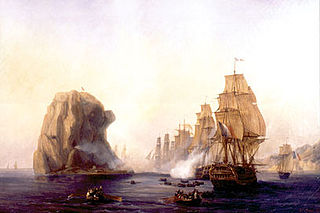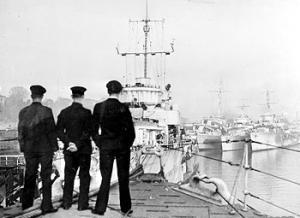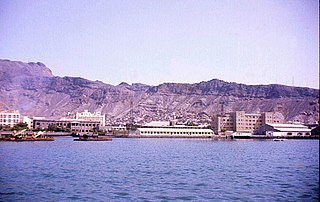Three ships and one shore establishment of the British Royal Navy have been named HMS Collingwood, after Admiral Cuthbert Collingwood, 1st Baron Collingwood:

Informally, a stone frigate is a naval establishment on land. The term has its origin in Britain's Royal Navy after its use of Diamond Rock, off Martinique, as a 'sloop of war' to harass the French. The command of this first stone frigate was given to Commodore Hood's first lieutenant, James Wilkes Maurice, who, with cannon taken off the Commodore's ship, manned it with a crew of 120 until its capture by the French in the Battle of Diamond Rock in 1805.

The Admiralty Mining Establishment originally known as the Mine Design Department was a technical department of the British Royal Navy responsible for both the design of naval mines and the development of suitable countermeasures from 1915 to 1951

A depot ship is an auxiliary ship used as a mobile or fixed base for submarines, destroyers, minesweepers, fast attack craft, landing craft, or other small ships with similarly limited space for maintenance equipment and crew dining, berthing and relaxation. Depot ships may be identified as tenders in American English. Depot ships may be specifically designed for their purpose or be converted from another purpose.

The Commander-in-Chief, China was a senior officer position of the Royal Navy. The officer in this position was in charge of the Navy's vessels and shore establishments in China from 1865 to 1941. He thus directed a naval formation, which was often known, even in official documents, as the China Station.

HMS Saker, also known as HMS Saker I, HMS Saker II and HMS Saker III, has historically been the ship to which Royal Naval personnel serving in the United States of America are assigned. Consequently, it is a stone frigate, and has existed at several different locations since the Second World War.

Coastal Forces was a division of the Royal Navy initially established during World War I, and then again in World War II under the command of Rear-Admiral, Coastal Forces. It remained active until the last minesweepers to wear the "HM Coastal Forces" cap tally were taken out of reserve in 1968.

HMS Mercury was a shore establishment of the Royal Navy, and the site of the Royal Navy Signals School and Combined Signals School. There was also a subsidiary branch, HMS Mercury II.

HMS Imperieuse was the name given to a floating Training establishment of the Royal Navy during the Second World War.

HMS Ferret was a shore establishment and naval base of the Royal Navy during the Second World War, located in Derry. It was given a ship's name as a stone frigate.

HMS Royal Arthur was a shore establishment of the Royal Navy, initially at Ingoldmells near Skegness, and later at Corsham, Wiltshire. During the Second World War, the former holiday camp at Ingoldmells was used to mainly train 'Hostilities Only' communications branch ratings and officers.
HMS Daedalus II was a British Royal Navy air station and training establishment between 1940 and 1946. The name applied to four different locations with the United Kingdom at various times during the Second World War. The establishment was formed to free up space at RNAS Lee-on-Solent .

HMS Forward was a shore establishment of the British Royal Navy during World War II. It was based at South Heighton, just outside Newhaven, East Sussex.

HMS Aggressive was a shore establishment of the British Royal Navy during World War II, based at Newhaven, East Sussex.

HMS Newt was a shore establishment of the British Royal Navy during World War II, based at Newhaven, East Sussex.

HMS Elfin was a torpedo recovery vessel built for the Royal Navy. She was built by J. Samuel White & Company, East Cowes, Isle of Wight, was launched on 20 November 1933 and commissioned on 16 January 1934. She was builder's number 1754. Her home port was the Navy's torpedo trials establishment HMS Vernon, and she was based at Portland. A sistership, Redwing, was constructed under builder's number 1753 and was stationed at HMS Defiance, Devonport. Elfin was renamed Nettle during the Second World War, and was later sold for scrapping. She survived in mercantile service, and has been preserved.

HMS Sheba also known as HM Naval Base, Aden was a Royal Navy shore base at Steamer Point in Aden. It was closed after South Yemen achieved independence in 1967.
The Commodore-in-Charge, Algiers was an administrative shore based appointment of the British Royal Navy established during World war II who was responsible for the berthing of all British convoys in Algeria and its sub-commands, facilities and staff from 1942 to 1946. The post holder was based at Allied Force Headquarters, Algiers. It was at first a sub-command of the Commander-in-Chief, Mediterranean Fleet then later the Commander-in-Chief, Levant.
The Senior British Naval Officer, Suez Canal Area was an administrative shore based command appointment of the Royal Navy established during World war II who was responsible superintending the naval base HMS Stag at Ismailia, Egypt it was a sub-command of the East Indies Station from 1939 to 1941 then the Mediterranean Fleet until 1942.
















